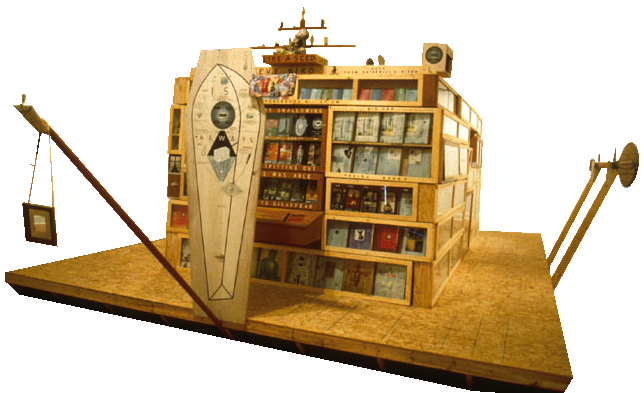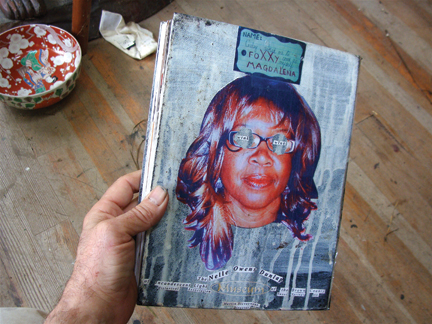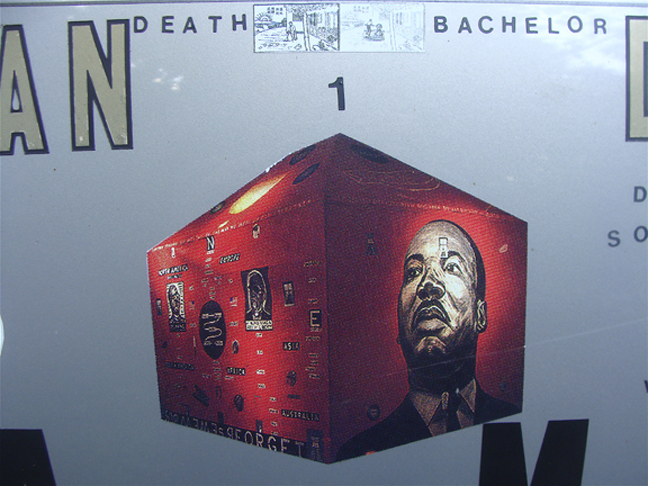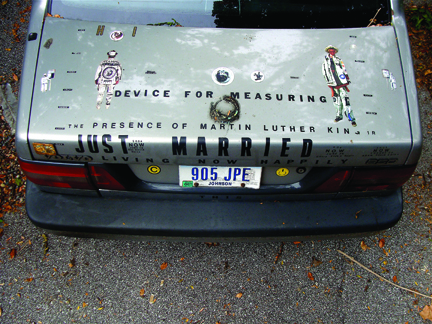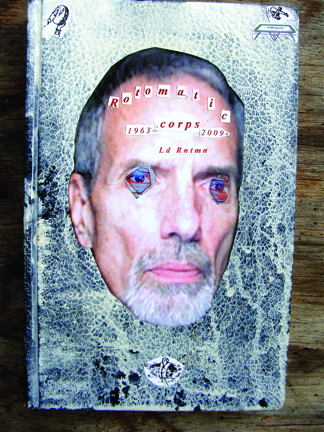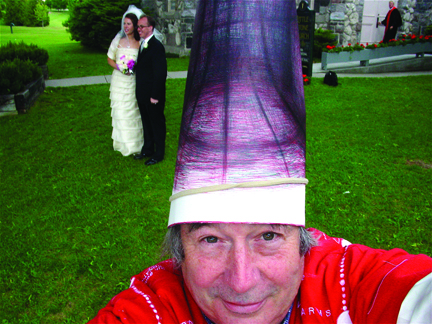David Dunlap
Curated by The Reeder Brothers
November 12, 2009 – January 8, 2010
In the spirit of friendship, passing this back and forth, I (David Dunlap) have collaborated with the following people, sometimes assuming a name: Rotomatic Corps, Phil Meyer, 1963-2009. Abracadabra, Susan Deming, Royce Dendler, 1967-90. The Living, Breathing Thing (FREE Art School), Jay Schmidt, 1966-2009, Wattle Daub, Michael Meyers, 1970-2009. Happy Cyclops Pottery, Michael Peed, 1975-2003
The Gitards, Melba Price ,Oakley Tapola, Bruce Tapola, 1980-2009, Grantana, Mel Andringa, Lloyd Dunn,1983-2009, Walnut Farms Inter-Species Artists Collective, Alva Gene Dexhimer, Emma Dunlap-Grube, Nelle Dunlap, Jane Gilmor, Victoria J. Grube, Andrea Loest, Philip Miller, Helen Neumann, Carrie Pollock, Alex Primm, Howard Rogovin, Bill Samualson, Irene Samualson, Scott Samualson, Ryan Standfest, DD Sunner, Britta Urness, Anthony Yoder, 1984-2009, The Story of the Rose, Hamlett Dobbins, 1991-2009. His River, Nathaniel Parsons, 1991-2009, The Teahouse of the White Flag of SURRENDER, Travis Freeman, 2000-09, Blue Hole Holler Dress + Honey Co, Maxine Payne, Clementine Ophelia Weeks, 2003-2008, T.I.S.H.A.M., Ed Bartlett, Sheridan Bartlett, Thomas Bartlett, Gabe Greenberg, 2004-09, The Mens Sewing Club, Pete Schulte, 2005-09, The Mens Fyloft Correspondence Club, Travis Head, Zach Stensen, 2006-09, ICCRPT, David Bendernagle, Maggie Booth, Jeremy Chen, Lydia Diemer, Josh Doster, Shawn Reed, 2006, Puppet Workshop, Mariah Dekkenga, Michael Perrone, 2006-09, The Obscenity Institute, Jill Baker, Jenn Myers, 2008, Paintallica, (Elders) Jesse Albrecht, Dan Attoe, Jamie Bolling, CeCe Cole, Bill Donovan, (Juniors) Posie Currin, Jeff Decker, Chris Miller, Jay Schmidt, Shelby S.C., Jeremy Tinder, 2008-09, The Gleaners, Caleb Engstrom, Andy Moeller, 2008-09 The Mens Cold Pork Drawing Club, Caleb Gentry, 2009.
Scott and Tyson Reeder are artists based in Milwaukee, Wisconsin who have been actively exhibiting work and curating in New York, Los Angeles and abroad for over a decade. Both painters, the Reeder brothers have also worked in sculpture, film, music and performance and have exhibited widely including shows at Daniel Reich Gallery, Jack Hanley Gallery, Pat Hearn and Gavin Brown's enterprise. Scott is known for his humorous approach to modernism and memorable titles like
Money in Bed and Symmetrical Pirate. His work will be featured in the upcoming group exhibition Abstract America at the Saatchi Gallery in London. Tyson Reeder paints imagined interiors, musicians, and regional landscapes with eccentric mixed-media surfaces and color. His work will be shown at Hiromi Yoshii gallery in Tokyo later this year and is in the collection of MoMA .
In addition to creating artwork, the brothers have an ongoing curatorial practice that began in 2002 with the opening of their own storefront gallery in Milwaukee; General Store. General Store went on to curate the legendary Drunk vs. Stoned exhibitions at Gavin Brown's enterprise, as well as the Early Showat White Columns in New York. Scott and Tyson are also members of Milwaukee International, a five person collective responsible for the Milwaukee International Art Fair, hosted at a Polish beer hall/bowling alley in Milwaukee, and the Dark Fair at the Swiss Institute in NY in 2008. In Spring 2009 they helped bring the Dark Fair to Cologne, Germany, at the Kölnischer Kunstverein and are working on the upcoming Ice Fair on a frozen lake in Winnipeg. Their paintings and projects have been reviewed inThe New York Times, Artforum, Art News, Art Review, Frieze, Flash Art, and the Village Voice.
ARTIST'S STATEMENT
T h e C o u r a g e t o M i s s p e l l
In Truth and Reconciliation Reparations
That summer the first thing we did was to make a Device for Measuring the PRESENCE of Martin Luther King Jr. Then Gelsy and I began to draw. We sat across from one another and drew back and forth, and in this exchange we spoke of those things we do for keeps, love and war. We were mindful of the saying "all's fair in love and war." We also spoke of the memory we hold deep in our bodies, of being eaten. We marveled at how we had learned to become a herd and in this knowledge were no longer eaten (alive).
Drawing back and forth we spoke of love. We spoke of the love that Martin Luther King Jr. described in his dream, the love we experience when we are part of a whole. Then we spoke of love when it is just us. In either case we realized love enters as a song. We remembered Martin singing his dream, then, thinking of love when it is just us, we listened to Ray Charles sing "I don't need no doctor."
SUDDENLY the Device for Measuring the PRESENCE of Martin Luther King Jr. began to move and we both exclaimed, "Let's write our artists statement about this!" Let's make our artists statement about how to conduct our selves when playing for keeps.
FIRST thing: NO zombies, NO water boarding, NO extraordinary rendition. We began to tell one another our experience with Zombies (Gelsy was Haitian-Canadian, often used "zombies," " royalty" in her work). We realized that zombies were the opposite of Martin Luther King Jr. They seemed to be present, but were not. They cast no shadows. When they apologized they always cried. Then we reflected on the times we had been zombies.
Whenever we reflected we would read from our textbooks, children's geography books from the time of Darwin. We would read the description of a lake: "A lake is a pool of still water." Tears would well up in our eyes at this. Then in the same voice we would read "The black race is a degraded race." It was then that we realized that broccoli was sentient, had a soul and that we were cannibals. We realized that evil is evil because you cannot always see it, because it does not always goose-step. Tears would well up in us at this.
Gelsy had an "I am a Man" project. She and those of us within her project would draw Martin Luther King Jr., as he would appear today. She, we took great liberties with his appearance (sometimes he looked like James Brown, sometimes he looked like Elizabeth Stanton). He was a living, breathing thing, not fixed. He was not what you expected (Gelsy sometimes called herself "The Unexpected Haitian"). I did not mean to, but I have a project, projects ("Ana Mendieta Foster Child of Iowa," "Kangying Guo, Brave and Resourceful," "The Swastika Drawing and Sewing Club," "The Burning Cross of Barack Obama"). I do not know what any of these projects mean or why I am involved with them. I can only trust there is something for me to learn.
Out of the blue Gelsy died (age 39) leaving behind her daughter Clara (named after Gelsy's mother). Now it is harder to pursue my projects. Now I have to say that recently I have been diagnosed with a rare form of Tourette's syndrome in which I am compelled to draw swastikas and Barack Obama Burning Crosses.
Gelsy Verna, NO water boarding David Dunlap, NO extraordinary rendition
CURATOR'S STATEMENT
by Scott and Tyson Reeder
This is Always Finished
David Dunlap is an artist, walnut farmer, and teacher living in Iowa City, Iowa. Since 1974, he has maintained a practice of keeping daily notebooks filled with drawings, words, lists, photos, dreams and sketches. The hundreds of numbered books are the building blocks for David's unique practice, a constantly evolving and mutating living document, both autobiographical and fiction, articulated through all media, including overflowing installations, hand-made suits covered with text, a 50-foot tower, pottery as clothes, and a Warhol-like obsession with capturing each fleeting moment with a camera or pen. Through these objects, Dunlap has created a universe of fellow artists, collaborators, friends and family who are all connected in some way to his story and practice.
Although Dunlap organizes his installations using a chronological framework, there are no clear beginnings or ends to his projects. A drawing from 20 years ago can suddenly reappear next to a drawing from two days ago; and through this re-contextualization becomes something altogether new and different. In the same way, there are few fixed physical boundaries between Dunlap's individual works; conventional ideas about the autonomy and hierarchy of medium do not apply. A ballpoint pen drawing might eventually end up attached to a kinetic sculpture, or a large scale wall painting could be reborn as a smaller but more engaging 4"x 6" photograph. This rejection of familiar models of artistic production are part of what gives Dunlap's work it's strength, but it's his unique touch as a draftsman and inventive use of text and image that really animates his practice. Experiencing a room full of Dunlap's delicately rendered drawings and obsessively reworked passages of text is like following a well-worn path up an old wooden staircase. You feel at the same time comforted and humbled; many other people have gone this way before you.
View CATALOGUE
YOUNG ART CRITICS: Melissa Tuckman on David Dunlap

